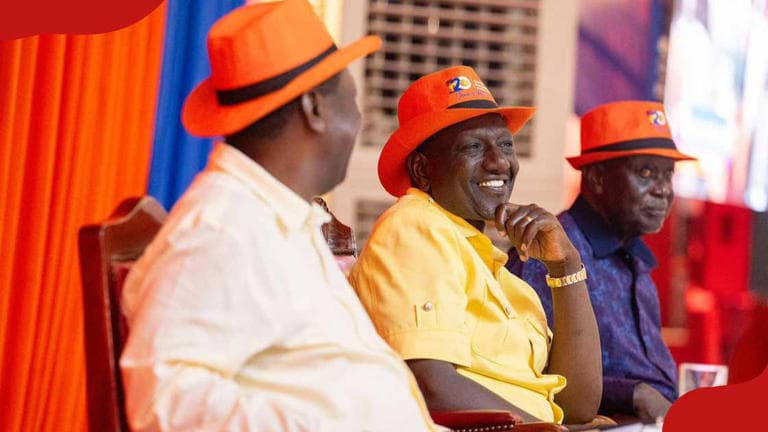Loading News Article...
We're loading the full news article for you. This includes the article content, images, author information, and related articles.
We're loading the full news article for you. This includes the article content, images, author information, and related articles.
Bungoma Governor Kenneth Lusaka’s forecast of the opposition’s demise before 2027 sharpens focus on the widening cracks within the Azimio la Umoja coalition, even as its leaders publicly vow to remain united against the Kenya Kwanza government.

Bungoma Governor Kenneth Lusaka has predicted that the opposition coalition will disintegrate before the 2027 General Election, citing escalating internal conflicts and public disagreements among its leaders. Speaking on Sunday, November 16, 2025, in Matete, Kakamega County, while campaigning for a UDA candidate, Lusaka, a key figure in the ruling Kenya Kwanza alliance, asserted that the opposition's unity is a “mirage” destined to fade.
“There is no possibility of the opposition coming together. What we are witnessing are widening rifts and constant quarrels, which show clearly that the coalition cannot survive up to 2027,” Lusaka stated. His comments add a significant voice from the government side to a growing national debate on the opposition's cohesion and strategic future.
Lusaka's prediction comes at a time of visible strain within the Azimio la Umoja One Kenya Coalition. A recent and public feud between DCP Deputy Leader Cleophas Malala and Trans Nzoia Governor George Natembeya of DAP-Kenya over by-election candidates in Kakamega has exposed deep-seated mistrust. During a rally on Friday, November 14, 2025, Malala accused Natembeya of being a state-sponsored “mole” paid to sabotage the opposition’s strategy, a claim Natembeya has denied as political propaganda. This dispute over an alleged coalition agreement for the Kisa East ward by-election highlights the fragile nature of local-level cooperation.
The Azimio la Umoja coalition, which was formally registered on April 21, 2022, with 26 constituent parties, has seen its numbers diminish. According to a notice from the Registrar of Political Parties dated February 25, 2025, the coalition now officially comprises 21 parties. Five parties have formally exited since the 2022 election: the People's Liberation Party (formerly NARC-Kenya), Maendeleo Chap Chap Party, United Democratic Movement, Devolution Empowerment Party, and Pamoja African Alliance.
A major point of contention is the Orange Democratic Movement's (ODM) continued participation in a “broad-based government” arrangement with President William Ruto's administration. ODM's Central Committee reaffirmed its commitment to this pact until 2027, a decision made under the guidance of its late leader, Raila Odinga. This collaboration has been branded a “betrayal” by other coalition partners. Leaders from the Wiper Democratic Movement and DAP-Kenya have publicly stated they can no longer remain in a coalition where a key partner is working with the government, announcing plans to form a new alliance by early 2025.
Despite the evident fractures, senior opposition leaders have consistently pushed back against narratives of collapse. On several occasions, Wiper Leader Kalonzo Musyoka has reiterated that the opposition will remain united to field a single presidential candidate in 2027. “Those saying we are disunited will have to wait a long time. We are united to make sure William Samoei Ruto goes home,” stated DAP-K leader Eugene Wamalwa at a joint political event on October 10, 2025. Speaking at his Yatta farm on September 5, 2025, Musyoka affirmed, “As political leaders, we agreed that first of all, we must have a team. The team is building up strongly.”
These declarations of unity are part of a broader strategy to form a formidable front against President Ruto. However, the question of who will lead such a ticket remains a complex and unresolved issue, with Musyoka, former Deputy President Rigathi Gachagua, and former Interior Cabinet Secretary Fred Matiang'i all seen as potential contenders.
The challenges facing Azimio are not new in Kenyan politics. The country has a long history of formidable coalitions that form to win elections but crumble shortly after due to internal power struggles and broken promises. The National Rainbow Coalition (NARC), which defeated KANU in 2002, disintegrated over a failure to honour a pre-election power-sharing Memorandum of Understanding. Similarly, the National Super Alliance (NASA) of 2017 was officially dissolved in August 2021 amid deep mistrust and disputes over political funds.
Political analysts note that these historical precedents cast a long shadow over the current opposition's ability to maintain a united front. The competing ambitions of party principals, coupled with fundamental disagreements over strategy—particularly ODM's relationship with the Kenya Kwanza government—present significant hurdles. Governor Lusaka, who is serving his second and final term, is a member of the Ford Kenya party, a key partner in the ruling Kenya Kwanza alliance. His prediction, therefore, serves not only as a political observation but also as a strategic jab from a rival camp keen on exploiting and deepening the existing opposition divisions ahead of the 2027 electoral contest.